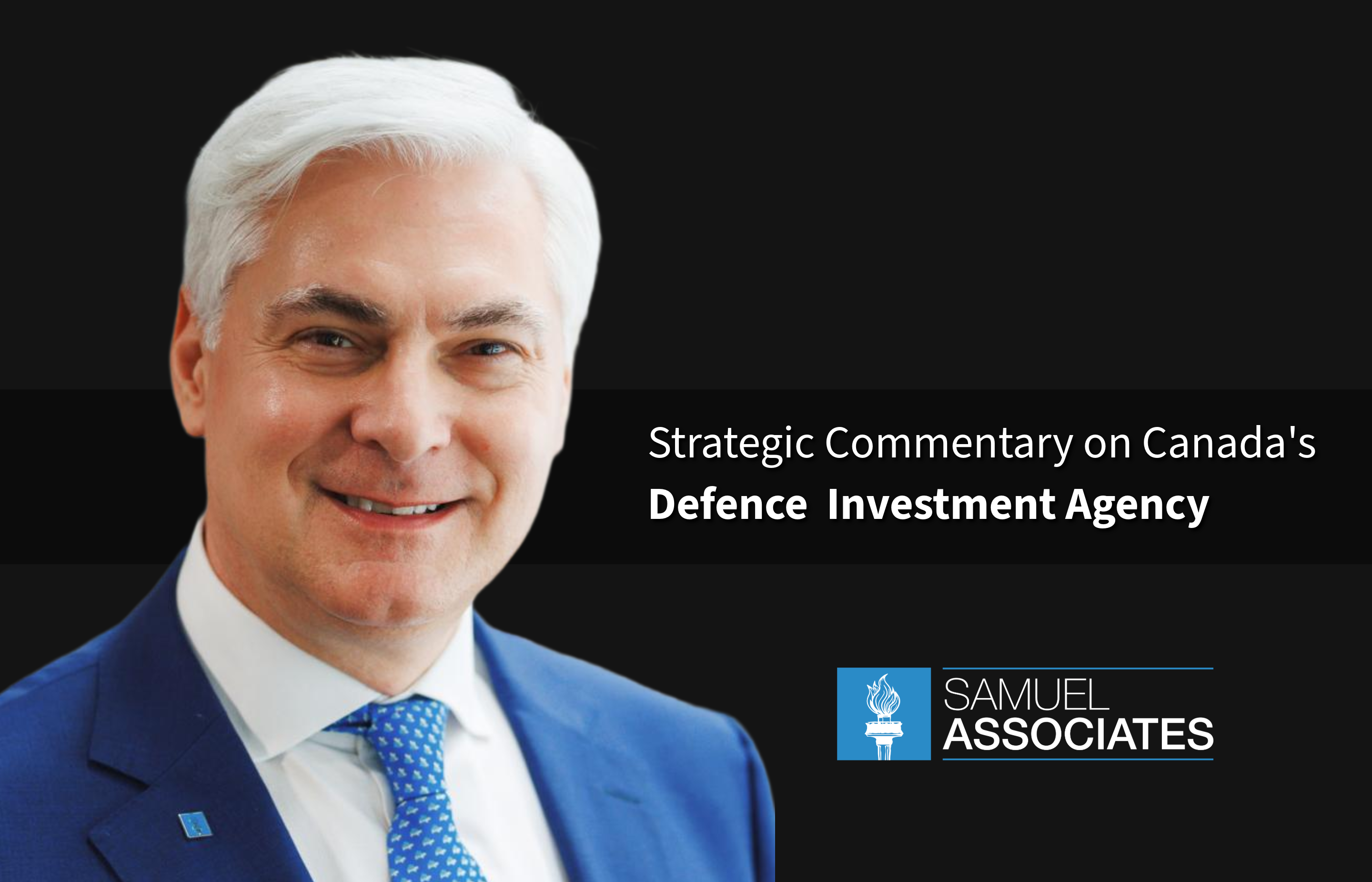How the Defence Investment Agency Signals a Strategic Reawakening


%4010x.png)
Digital Marketing & Communications Specialist
Samuel Associates Inc.
When Prime Minister Mark Carney announced the creation of the Defence Investment Agency (DIA), it marked far more than an administrative clean-up of Canada’s procurement system. It signalled the emergence of a new doctrine of Canadian statecraft—one in which defence, industrial policy, and economic sovereignty are fused into a single strategic enterprise.
For a country long accustomed to incremental reform and chronically cautious defence investment, the launch of the DIA represents a decisive break with the past. It is Canada’s answer to a world that has grown more volatile, more contested, and less forgiving of nations that outsource their security or their industrial base. In short: Canada is rearming not only its military, but its capacity to act as a credible power.
The Strategic Imperative Behind the DIA
PM Carney’s government has embraced a blunt assessment of Canada’s security environment: deterrence now requires speed, domestic production, and the ability to mobilize national resources at scale. Canada’s existing procurement architecture—fragmented across departments, slow to align military requirements with industrial reality, and notoriously labyrinthine—was incompatible with this new reality.
The Defence Investment Agency is therefore designed to correct three systemic failures:
Fragmentation of Authority
Procurement responsibilities have historically been spread across Public Services and Procurement Canada, National Defence, Innovation, Science and Economic Development Canada, and Treasury Board. The result: no unified chain of accountability, long delays, and unclear ownership.
Absence of Early Operational-Industrial Dialogue
CAF requirement-setting has rarely been synchronized with Canada’s industrial capacity, leading to unrealistic timelines, misaligned expectations, and an overreliance on foreign primes.
Lack of Strategic Industrial Vision
Unlike allied counterparts—France’s DGA, the UK’s DE&S, Australia’s CASG—Canada lacked a mechanism to weld defence acquisitions to national industrial strategy.
The DIA is designed as the remedy: a central, professional, investment-driven institution capable of delivering speed, coherence, and strategic intent.
Industrial Power as National Strategy
In unveiling the DIA, the government has effectively adopted a doctrine that many U.S. and European policymakers have rediscovered since 2022: industrial capacity is national security.
Rather than treating defence procurement as a sequence of one-off acquisitions, the DIA will:
- Expand domestic manufacturing lines
- Build sovereign supply chains
- Tie major projects to sustainable job creation
- Strengthen aerospace, naval, and advanced manufacturing clusters
- Incentivize dual-use innovation
- Position Canada as a competitive exporter of defence technology
This approach mirrors the logic behind the EU’s Readiness 2030 plan and America’s revived defence-industrial mobilization. Ottawa is clearly signalling that prosperity and security are no longer separate domains—they are mutually reinforcing.
PM Carney’s appointments also reflect this shift. By choosing Doug Guzman, formerly Deputy Chair of RBC, as DIA’s inaugural CEO, he is bringing financial-sector discipline into defence acquisition. Mr. Guzman’s background suggests a move toward investment-grade procurement, co-development with industry, and strategic capital allocation—models used successfully in the U.S. and Europe but never fully adopted in Canada.
A System Built for Speed and Predictability
One of the greatest weaknesses of Canadian defence procurement has been its inability to deliver equipment “when the military needs it, not decades later.” The DIA is explicitly mandated to change this.
Key reforms include:
- Consolidated approvals under a single authority
- Integrated procurement teams that combine military, policy, technical, and legal expertise
- Standardized risk assessment and transparent milestones
- Earlier and continuous industry engagement
- Reduced redundancy with Treasury Board and PSPC
- Stronger forecasting tools for long-term capability planning
This system is designed to emulate the high-functioning procurement bodies of allied democracies—where speed, predictability, and accountability are foundational principles.
Embedding Canada in Allied Defence Architecture
Canada’s new agency is not just domestically focused; it is inherently geopolitical.
By establishing the DIA, Canada aims to become a fully interoperable industrial partner with:
- The United Kingdom
- France
- Australia
- The broader European Union industrial base
This aligns Canada with the major western democracies that have already created specialized procurement agencies capable of conducting joint acquisitions, integrating supply chains, and reinforcing collective resilience.
It also positions Canada more strategically within NATO at a moment when the Alliance is redefining defence burden-sharing through industrial output as much as through spending targets.
Indeed, PM Carney’s decision to commit to 2% of GDP for defence in 2025 and 5% by 2035 is only half the story. The DIA provides the machinery capable of translating those funds into actual capability.
Canada’s past failure to deliver on major projects—the fighter replacement, naval modernization, Arctic surveillance—undermined its reputation. The DIA is intended to restore that credibility by giving Ottawa a credible, professional mechanism for rapid delivery.
The DIA as a Structural Reform of the Canadian State
If successful, the DIA will do more than accelerate procurement. It will reshape the Canadian state in four profound ways:
1. Defence Becomes a Driver of National Industrial Policy
Aerospace, shipbuilding, cyber, AI, autonomy, and advanced materials will benefit from long-term demand, stable investment horizons, and clearer industrial pathways.
2. Canada Reduces Its Dependence on Foreign Defence Primes
Domestic integrators—both traditional and emerging—will gain greater access to major programs, enabling a more sovereign defence ecosystem.
3. Ottawa Gains Strategic Flexibility
With faster procurement cycles and more resilient domestic production, Canada can respond to geopolitical shocks more effectively.
4. A New Era of Bureaucratic Power Rebalancing
The DIA’s centralization of procurement authority will inevitably shift influence away from traditional centres of decision-making, including PSPC and Treasury Board. This will be politically sensitive but institutionally transformative.
What Comes Next: Our Predictions
Drawing from allied experience and Canada’s own political trajectory, the following outcomes are likely in the near term:
A First Wave of High-Priority Projects (2026–2030)
Expect rapid movement on:
- Maritime patrol and naval modernization
- Arctic mobility and surveillance systems
- Ground-based air defence
- Munitions stockpile regeneration
- Space and cyber resilience programs
- NORAD modernization assets
These will serve as proof-of-concept successes for the DIA.
Emergence of Canadian Defence Champions
With long-term demand more predictable, Canadian primes and mid-sized firms could rise in:
- ISR and remote sensing
- Shipbuilding and naval systems
- Uncrewed systems and autonomy
- Cybersecurity and software-defined capability
- Munitions and advanced materials
New Public–Private Investment Models
The DIA may eventually introduce sovereign investment funds or cost-sharing mechanisms to accelerate industrial readiness.
Politically, Increased Complexity
Centralization will generate friction with:
- Provincial governments seeking regional benefits
- Treasury Board over project governance
- Departments losing authority in the new structure
Success will depend on disciplined political backing.
Strengthened Canada–U.S. Defence Integration
Rather than being threatened by Canadian reindustrialization, Washington is likely to embrace it, particularly for NORAD modernization and allied supply-chain resilience.
By 2030, the DIA Could Become One of the Most Powerful Agencies in Ottawa
If procurement accelerates and early wins materialize, the DIA’s influence will expand significantly—potentially reshaping Canada’s defence bureaucracy for a generation.
The Return of Canadian Hard Power
The Defence Investment Agency is more than an institutional reform. It is a declaration of national intent. For the first time in decades, Canada is rebuilding the material foundations of sovereignty: industrial strength, rapid procurement, allied interoperability, and defence capabilities measured in readiness—not rhetoric.
If PM Carney’s reforms hold, Canada will enter the 2030s not as a peripheral military power, but as a credible, integrated, industrially capable partner at the heart of the transatlantic and Indo-Pacific security architecture.
In an era defined by hard choices and geopolitical rearmament, the DIA may prove to be the most significant Canadian defence initiative of the century.
%4010x.png)
%4010x.png)





